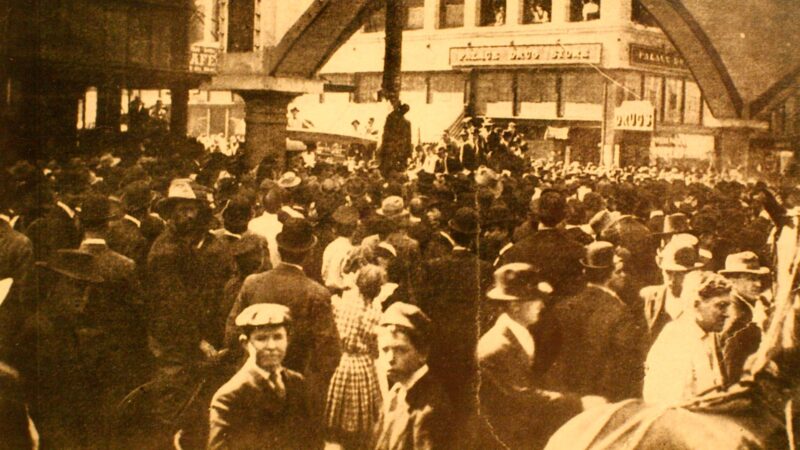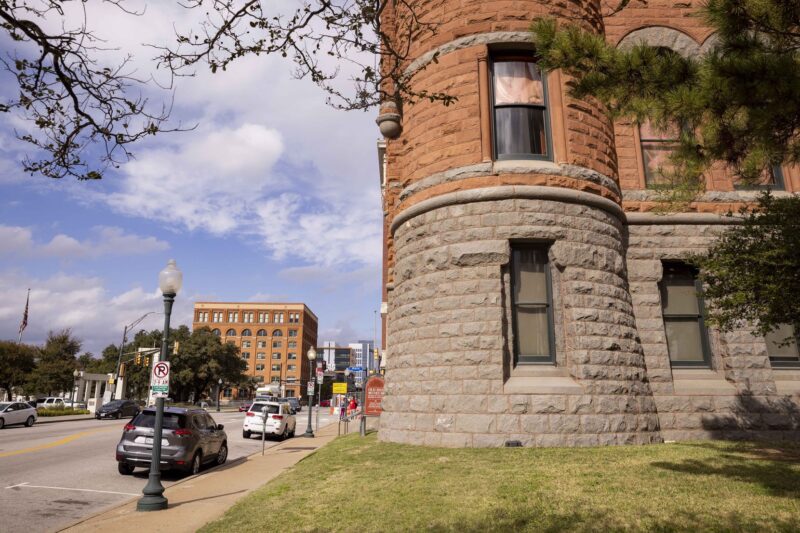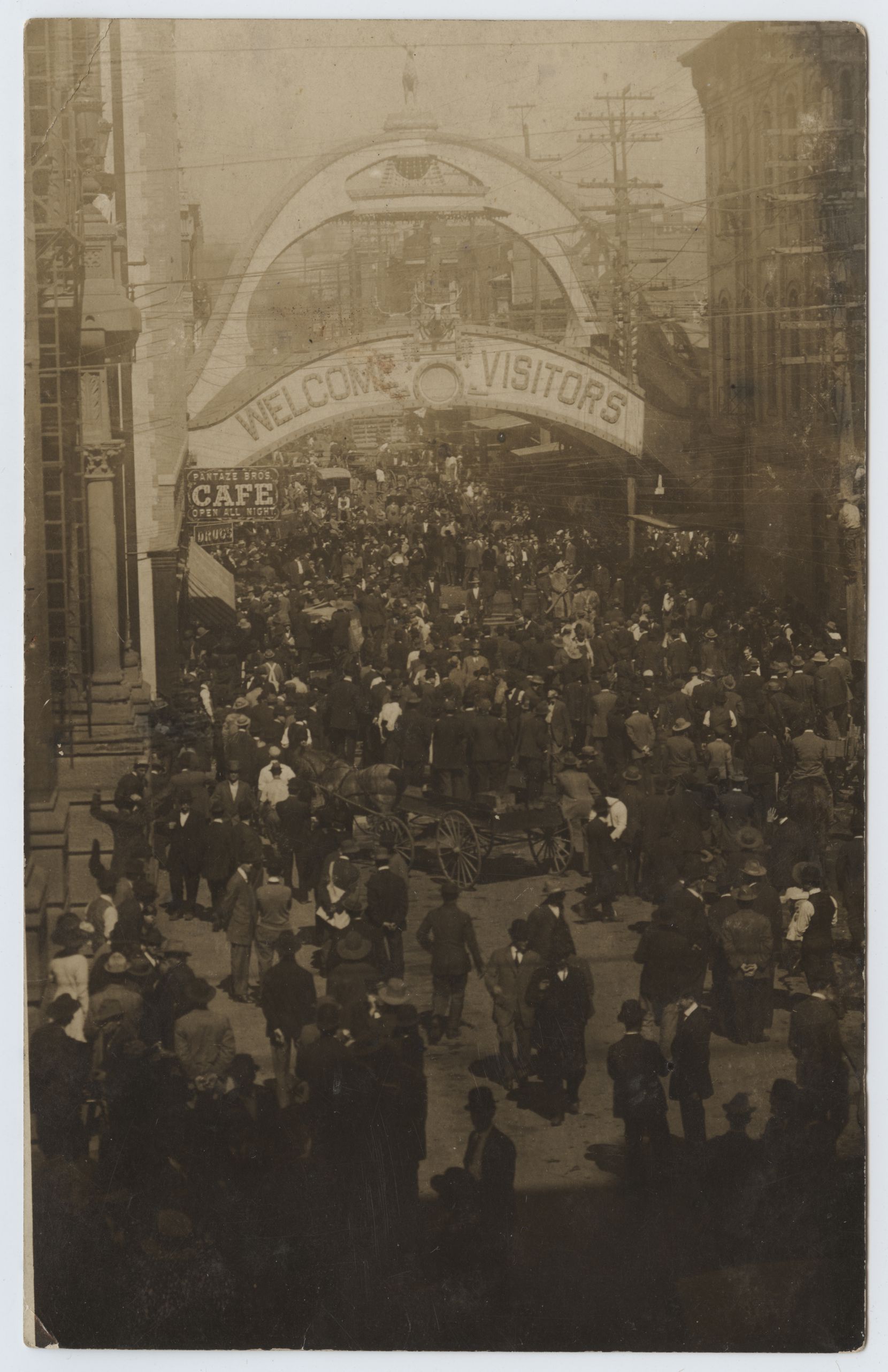By Sharon Grigsby

Not a single photo exists of 59-year-old Dallas handyman Allen Brooks — except the one depicting the March 3, 1910, spectacle of the Black man’s lifeless body strung up on a utility pole to the delight of the thousands gathered at the northeast corner of downtown’s Akard and Main streets.
That photograph was immediately turned into a souvenir postcard.
It celebrated lynching’s power in the service of white supremacy. It paid homage to the local citizenry’s willingness to carry out torture and murder to repress and terrorize people of color.
The heinous injustice done to Allen Brooks — accused of a crime, then murdered before he got his day in court — is irreparable.
But for a city that too often pretends the shameful episodes in our history simply didn’t happen, a ceremony at 11 a.m. Saturday is a significant moment in Dallas’ reckoning with the violence wrought by racism.
A heavy blue and gold historical marker to be unveiled at the lynching site — commemorating Brooks’ life and acknowledging this ugly stain of the past — will stand as our city’s first permanent and public acknowledgment of what happened on this corner more than 111 years ago.
Long, long overdue, yes. But it’s nonetheless a blow against the intentional forgetfulness we have traditionally invoked.
“Confronting and addressing the wrongs of the past begins with making it visible,” George Keaton Jr., founder of Remembering Black Dallas, told me amid final preparations for the ceremony at Pegasus Plaza.
“This is a huge step for Dallas to even consider allowing the Black community to recognize this tragedy.”

Keaton has led a diverse coalition of Dallas County volunteers working for more than two years to secure the historical marker from the Equal Justice Initiative, whose National Memorial for Peace and Justice in Montgomery, Ala., is a shrine to the victims of lynching.
Bryan Stevenson, EJI’s creator and a man who has devoted his entire life to confronting racial discrimination in the legal system, said he’s excited to see Dallas recognize its past.
“Truthfully confronting our history is the only way to create a future without racial bigotry and injustice,” he wrote to me a few days ago. “The lawless mob violence that resulted in hundreds of lynchings in Texas was tragic and should be understood and acknowledged.”
Accused of the attempted sexual assault of a white child in a home where he tended the family furnace, Allen Brooks was awaiting legal proceedings when a mob stormed the Old Red Courthouse. He was thrown headfirst through a second-floor window, a fall that almost certainly killed him, and dragged a half-mile to the lynching site at Akard and Main.
After the marker is unveiled Saturday at that intersection, community members will walk, alongside a solemn drum recessional, to the Old Red Courthouse and lay 59 red roses, one for each year of Brooks’ life, on the ground where he fell.
It’s especially important as Saturday’s milestone nears that we remember who Allen Brooks was and consider his lot in life before his murder.
Local research compiled for the EJI-sponsored marker determined that Brooks was born in Maryland in the mid-1850s, almost certainly a member of an enslaved family. At some point, he wound up in Texas. Whether his family was sold or forced to move when their captors did, we don’t know.
Fifteen years after the Emancipation Proclamation, Brooks married Milly Lawson in 1878. They lived in what was then called North Dallas or, simply, Freedman’s Town, where Uptown is today.
Records show Brooks did a stint at the Dallas County Poor Farm for theft and went on to work for years as a laborer, cook, house cleaner, carpenter and janitor.
To get work to help support his wife and their nine children, Brooks “went from pillar to post,” whether as far away as Waxahachie or in the homes and businesses of downtown Dallas, Keaton said.
Efforts over the years to find any of Brooks’ descendants have been unsuccessful. Most recently, I tried to track down Lillie May Taylor, a Dallas woman who identified herself as a granddaughter, only to find she passed away in 2013, leaving no survivors whom I could locate.

No one knows more about the Allen Brooks story than Keaton, who directs the Dallas County Justice Initiative, the group created to lead EJI’s Community Remembrance Historical Marker Project. This coalition, with the help of hundreds of other volunteers, did the extensive research, community meetings and student outreach required for each marker.
Allen Brooks’ 1910 lynching and the events leading up to it were breathlessly recounted in newspapers — including The Dallas Morning News — across the state. In the relentless drumbeat designed to explain away and even encourage racial violence, Brooks was demonized and the mob glorified.
The newspaper articles, part of the documentation that the Dallas County group compiled for EJI, include one from a Houston-based reporter who characterizes Brooks as “so heinous, so devilish, so beastial that even murder pales in infamy.”
Five-year-old Mary Ethel Buvens, whose family lived at Ross and Pearl streets, reportedly had gone missing for a few hours in late February 1910. Flora Dangerfield, a Black woman who cooked for the Buvens family, claimed to have found Brooks with the child.
A doctor examined both Brooks and the 5-year-old, but no injuries were listed in even the most sensational newspaper accounts.
Nonetheless, the handyman was indicted on a charge of attempted rape, and vigilantes sent the loud message that no trial would take place.
They first stormed the county jail, but Sheriff Arthur Ledbetter managed to keep Brooks’ whereabouts a secret — until the afternoon of March 3, when Brooks sat in an Old Red holding room, just off a courtroom, while his lawyer argued to be allowed time to gather evidence.
A mob of at least 3,000 white men converged, and despite the chains and ropes barricading the courthouse entrance, some rushed the stairs to the second floor, seized Brooks and, after tying a rope around his body, threw him from the window.
Mob members on the ground below surrounded Brooks, kicking and beating him before dragging him to Main and Akard and stringing up his mutilated body from a telephone pole adjacent to an ornate archway.
Spectators tore away Brooks’ clothing as souvenirs to carry home with them.

Recently discovered burial records show that Brooks’ body was interred in an unmarked grave in Oakland Cemetery, its exact location unknown. The cause of death: Lynched by mob.
No one was ever held responsible.
In the frilly longhand handwriting style of the day, Dallas County court records from March 1-5, 1910, closed out the case: ”While the attorneys were preparing the motion, a mob entered the Courtroom and killed the defendant. Cause dismissed.”
As Keaton and I examined a jar holding soil taken from the lynching site, he acknowledged that it’s still hard to believe the public marking of this tragedy is finally near.
“This is a major milestone — to recognize such a horrible crime and really look at the violent behavior,” he said. “This is something Southerners just don’t like to do.”
The Dallas County marker is only the third that EJI has released in Texas from its list of 336 documented lynchings. One was dedicated in 2017 in Austin and another the next year in the small East Texas town of Center.
Among the requirements to secure a marker are the completion of a series of blunt conversations on race, attended by people from all over the county, educational projects and an essay scholarship contest among high schools.
The Dallas coalition also has completed the application to secure a marker for the county’s second EJI-recognized lynching victim, William Taylor, who was hanged by a mob after a supposed assault of a woman in 1884.
That marker ceremony, to take place at what is now the Trinity Lookout off Commerce Street, is set for September 2022.
Keaton still has trouble describing the level of anger and hate he experienced during the public discussions about removing the city’s Confederate monuments. That’s a big reason he took on this marker project.
“Our job, the Dallas County Justice Initiative’s job, is to try to help people know the truth,” he told me.
He expects the reaction to Saturday’s public event will be a good gauge for where Dallas County stands on racial justice issues.
“If it’s really, really bad, that means we’ve got a really, really lot more work to do,” he said. “If it’s kinda OK, it means we might be getting there. If it’s subtle, that means maybe we’ve done our job or we have a group of people in Texas now that have a different mindset.
“I’m waiting to see.”









